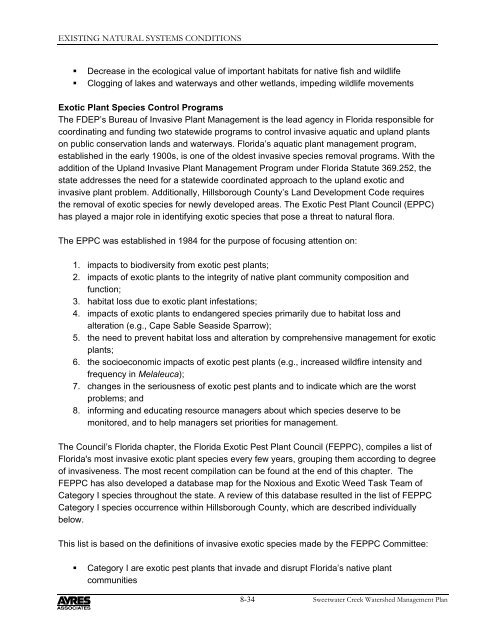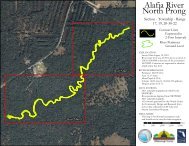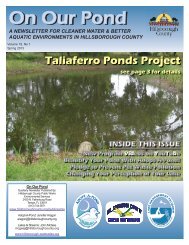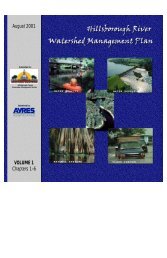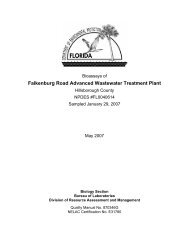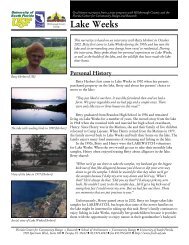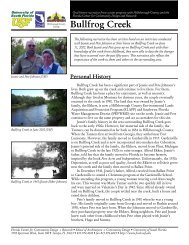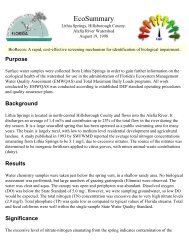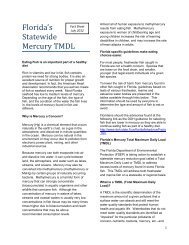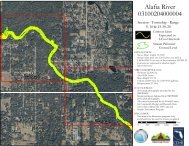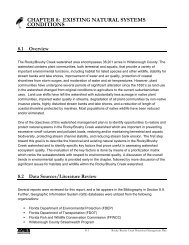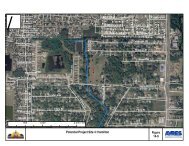Sweetwater Creek Watershed Mgmt. Plan 2007 Update--Part 2
Sweetwater Creek Watershed Mgmt. Plan 2007 Update--Part 2
Sweetwater Creek Watershed Mgmt. Plan 2007 Update--Part 2
Create successful ePaper yourself
Turn your PDF publications into a flip-book with our unique Google optimized e-Paper software.
EXISTING NATURAL SYSTEMS CONDITIONS<br />
• Decrease in the ecological value of important habitats for native fish and wildlife<br />
• Clogging of lakes and waterways and other wetlands, impeding wildlife movements<br />
Exotic <strong>Plan</strong>t Species Control Programs<br />
The FDEP’s Bureau of Invasive <strong>Plan</strong>t Management is the lead agency in Florida responsible for<br />
coordinating and funding two statewide programs to control invasive aquatic and upland plants<br />
on public conservation lands and waterways. Florida’s aquatic plant management program,<br />
established in the early 1900s, is one of the oldest invasive species removal programs. With the<br />
addition of the Upland Invasive <strong>Plan</strong>t Management Program under Florida Statute 369.252, the<br />
state addresses the need for a statewide coordinated approach to the upland exotic and<br />
invasive plant problem. Additionally, Hillsborough County’s Land Development Code requires<br />
the removal of exotic species for newly developed areas. The Exotic Pest <strong>Plan</strong>t Council (EPPC)<br />
has played a major role in identifying exotic species that pose a threat to natural flora.<br />
The EPPC was established in 1984 for the purpose of focusing attention on:<br />
1. impacts to biodiversity from exotic pest plants;<br />
2. impacts of exotic plants to the integrity of native plant community composition and<br />
function;<br />
3. habitat loss due to exotic plant infestations;<br />
4. impacts of exotic plants to endangered species primarily due to habitat loss and<br />
alteration (e.g., Cape Sable Seaside Sparrow);<br />
5. the need to prevent habitat loss and alteration by comprehensive management for exotic<br />
plants;<br />
6. the socioeconomic impacts of exotic pest plants (e.g., increased wildfire intensity and<br />
frequency in Melaleuca);<br />
7. changes in the seriousness of exotic pest plants and to indicate which are the worst<br />
problems; and<br />
8. informing and educating resource managers about which species deserve to be<br />
monitored, and to help managers set priorities for management.<br />
The Council’s Florida chapter, the Florida Exotic Pest <strong>Plan</strong>t Council (FEPPC), compiles a list of<br />
Florida's most invasive exotic plant species every few years, grouping them according to degree<br />
of invasiveness. The most recent compilation can be found at the end of this chapter. The<br />
FEPPC has also developed a database map for the Noxious and Exotic Weed Task Team of<br />
Category I species throughout the state. A review of this database resulted in the list of FEPPC<br />
Category I species occurrence within Hillsborough County, which are described individually<br />
below.<br />
This list is based on the definitions of invasive exotic species made by the FEPPC Committee:<br />
• Category I are exotic pest plants that invade and disrupt Florida’s native plant<br />
communities<br />
8-34<br />
<strong>Sweetwater</strong> <strong>Creek</strong> <strong>Watershed</strong> Management <strong>Plan</strong>


